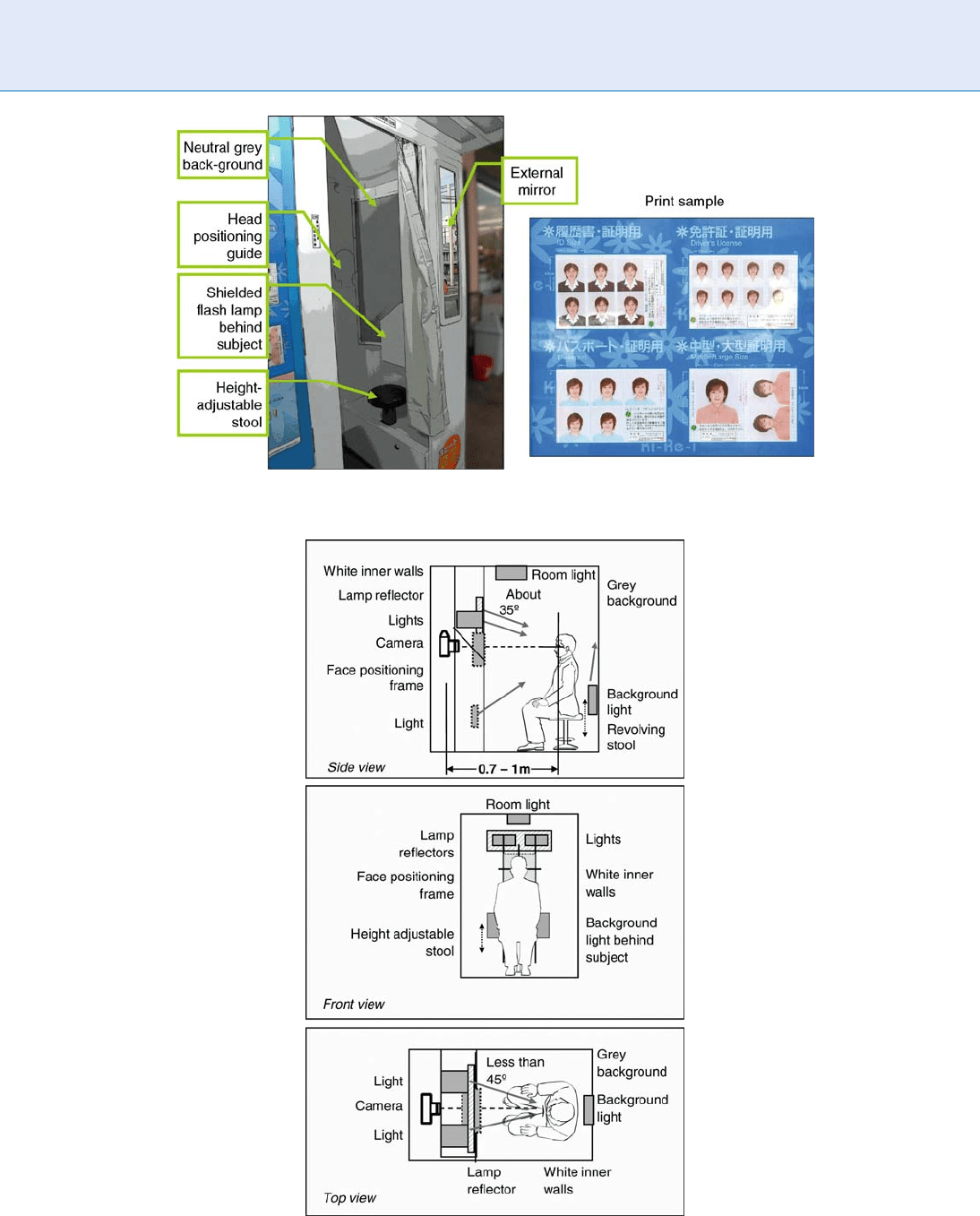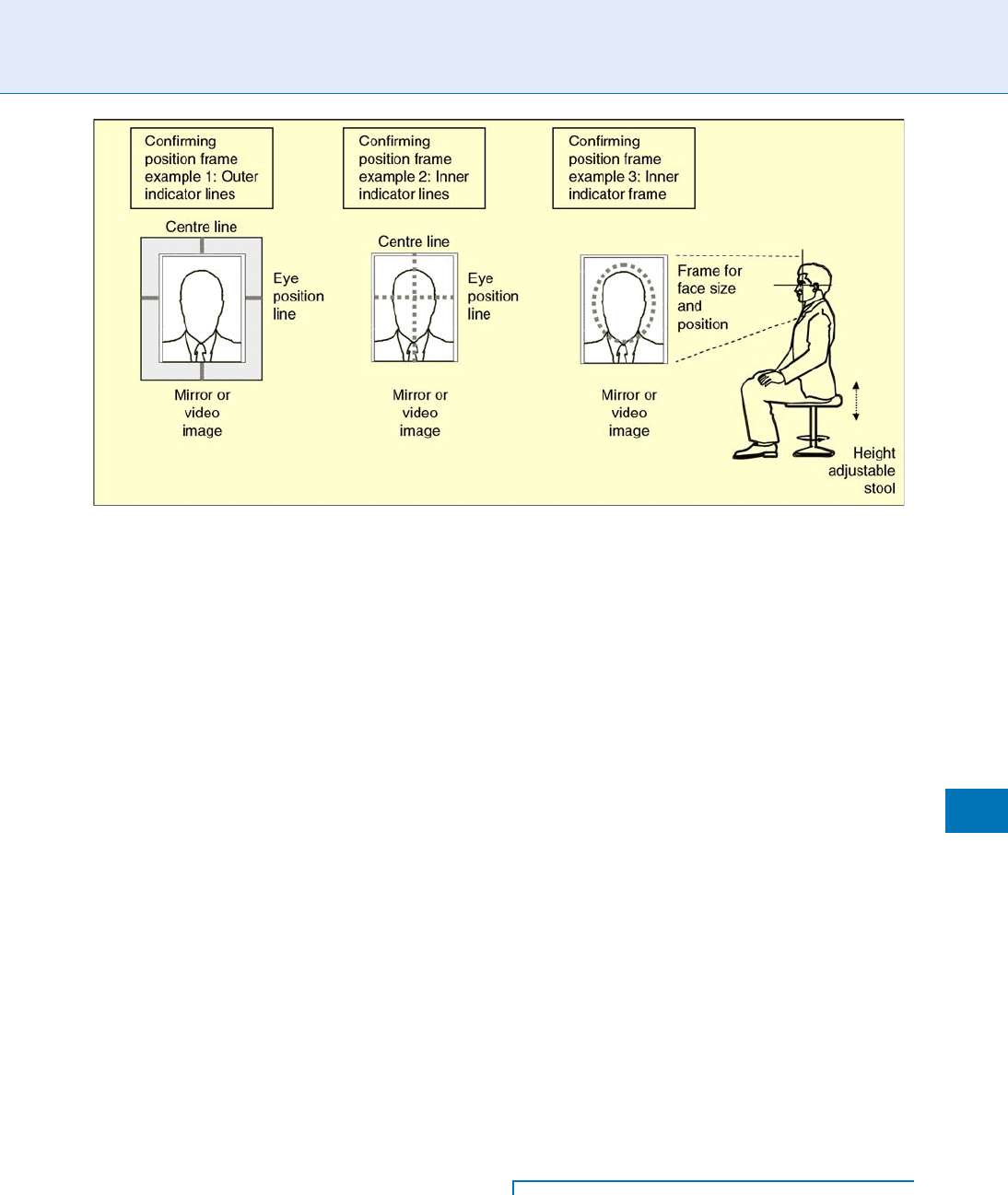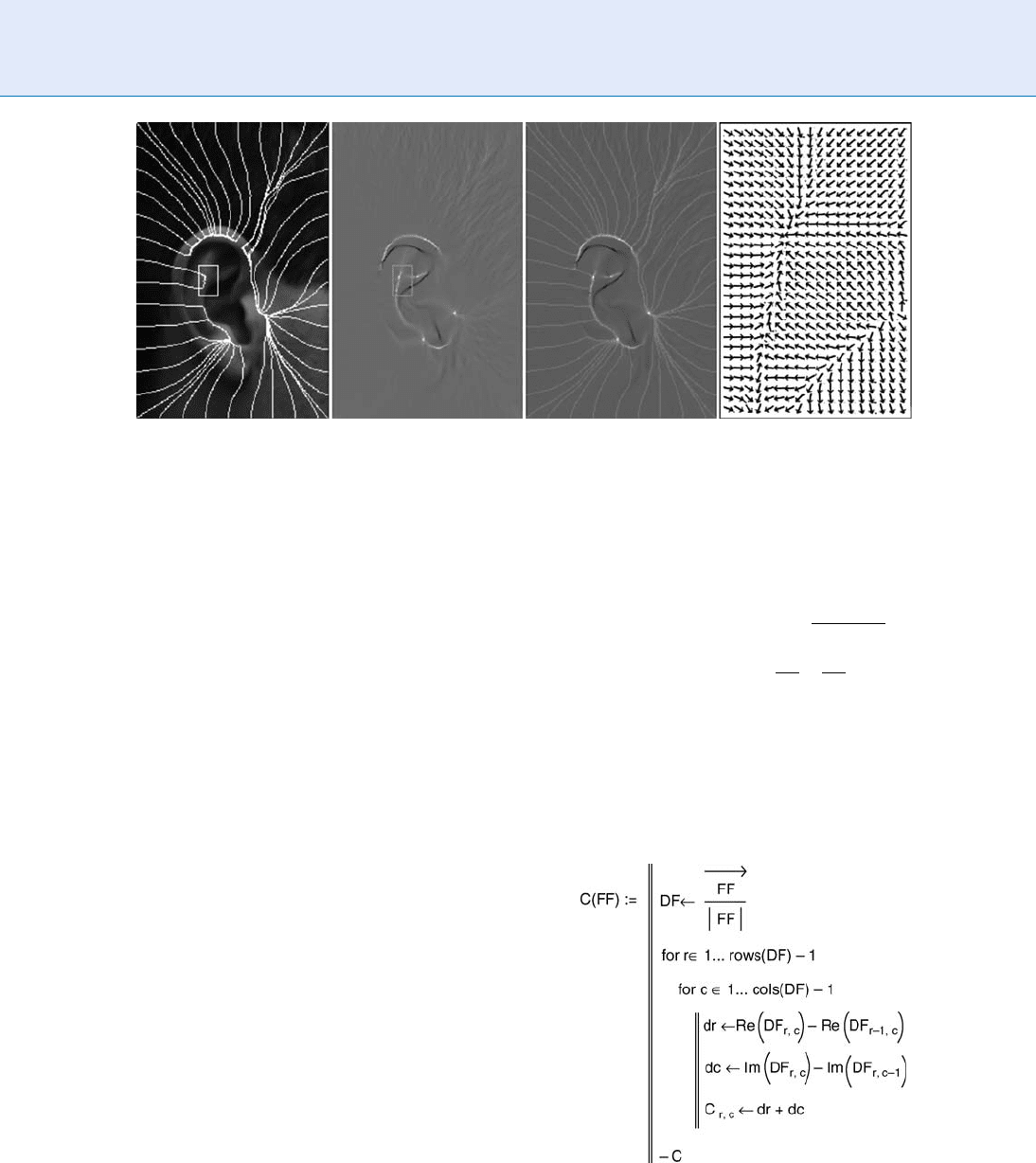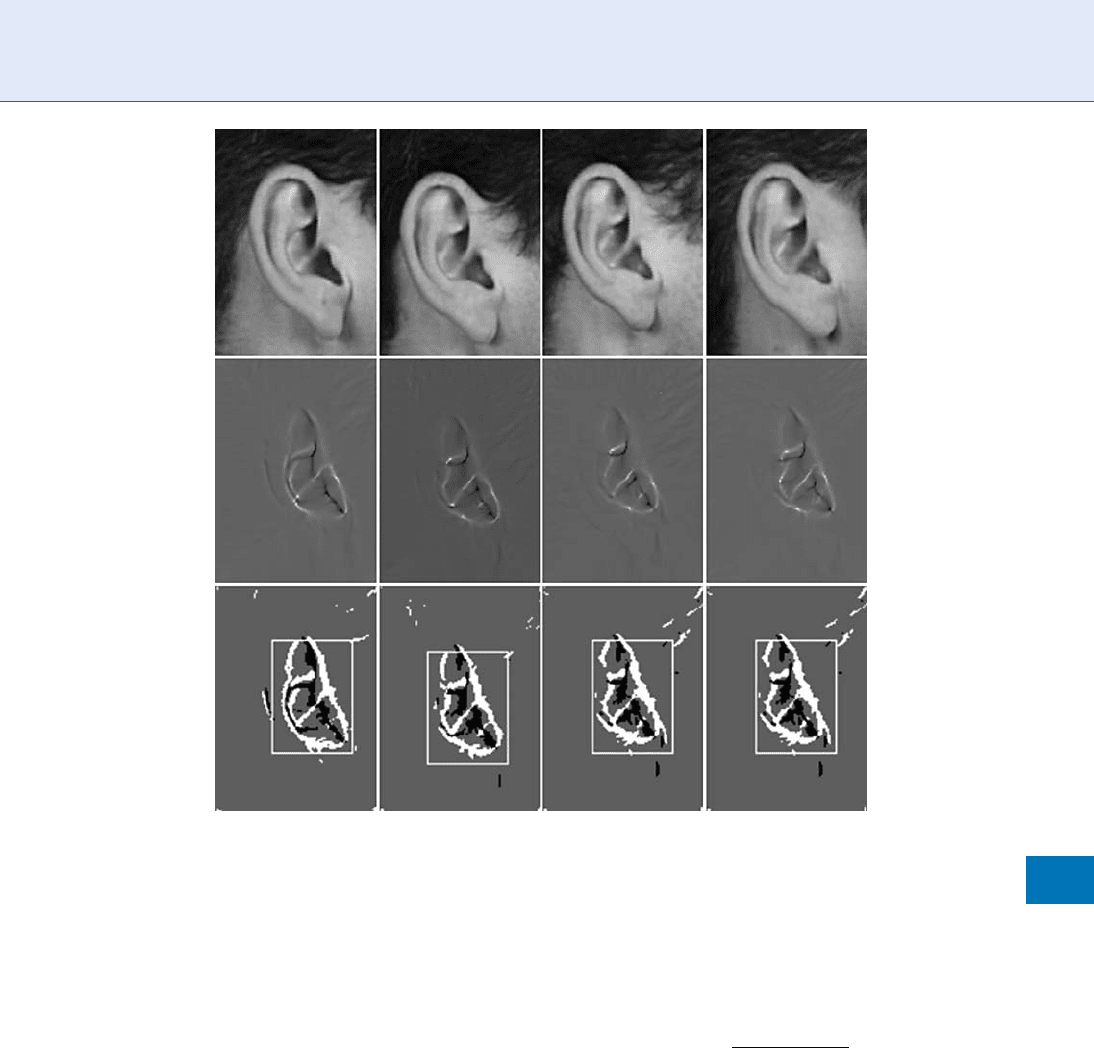Li S.Z., Jain A.K. (eds.) Encyclopedia of Biometrics
Подождите немного. Документ загружается.


Photography for Face Image Data. Figure 5 Example of a photo booth(2).
Photography for Face Image Data. Figure 6 Light and camera arrangement for a photo booth.
1080
P
Photography for Face Image Data

specular reflections on the face, and deep shadows on
background (which can blend with thesubject’s dark
hair, etc.), improve the accuracy of automated face rec-
ognition systems. Other factors that can affect face image
quality include pose, expression, and positioning. In-
creasingly, face image quality assessment software is
being used to ensure high quality face images, for the
preparation of not only e- , but also other ID documents.
Related Entries
▶ Enrollment
▶ Facial authentication
▶ Facial identification
▶ Facial verification
References
1. ‘‘Machine Readable Travel Documents, Part 1, Machine Read-
able Passports,’’ ICAO Doc9303 6th edn. 3rd draft, 18, Nov.
(2004)
2. FRVT2002. http://www.frvt.org/FRVT2002/default.htm
3. Phillips, P.J., et al.: FRVT 2006 and ICE 2006 Large-Scale Results,
NISTIR 7408, National Institute of Standards and Technology,
Gaithersburg, MD 20899, USA. http://face.nist.gov/frvt/frvt2006/
frvt2006.htm 9. Guidelines of USA, UK, Australia and Canada
4. ISO/IEC 19794-5:2005, Information Technology – Biometric
Data Interchange Formats – Part 5: Face Image Data (2005)
5. http://travel.state.gov/pdf/Photo%20Guide%2010-01-04.pdf
6. http://www.ips.gov.uk/passport/downloads/Photographers-guide-
to-passport-photos-edited.pdf
7. https://www.passports.gov.au/Web/Requirements/Photos.aspx
8. http://www.ppt.gc.ca/cdn/photos.aspx; http://www.ppt.gc.ca/
form/pdfs/pptc320_eng.pdf
9. ISO/IEC 19794-5:2005, Information technology – Biometric data
interchange formats – Part 5: Face image data – AMENDMENT 1:
Conditions for taking photographs for face image data (2007)
10. Commissioned Report: Studies on Biometric Authentication
Using IC Passports. http://www.nmda.or.jp/nmda/bio/ic-pass
ports/ic-passports.pdf
11. Junichi Sakaki, Shizuo Sakamoto, Koji Matsunaka et al.: [Special
Talk] IC Passports and Systematic Evaluation toward Employing
Face Authentication Technologies, IEICE (The Institute of Elec-
tronics, Information and Communication Engineers) technical
report PRMU2005-92 (2005–10), pp. 51–56, (2005)
12. D’Amato , D .P.: Best Practices for Taking Face Photographs
and Face Image Quality Metrics NIST Biometric Quality Work-
shop. http://www.itl.nist.gov/iad/894.03/quality/workshop/proc/
d’amato_nist_image_quality_workshop_slides-final.pdf Accessed
8 March (2006)
Photography Guidelines
▶ Photography for Face Image Data
Photography for Face Image Data. Figure 7 User interface: Head positioning frame.
Photography for Face Image Data
P
1081
P

Photometric Guidelines
▶ Photography for Face Image Data
Photon
In classical electromagnetic theory, light and other
forms of electromagnetic radiation propagate as
waves. Quantum mechanics teaches us that nature is
more complicated; light propagation can be modeled
as either a wave or a particle, depending on the view-
point and measurement process of the observer. A
photon is a ‘‘particle’’ of light, in the same sense that
an electron is a ‘‘particle’’ of electricity. When light is
absorbed by a piece of silicon in an camera sensor, the
model for the interaction is that photons of light are
individually absorbed by the silicon and excite elec-
tron-hole pairs in the silicon that result in an electrical
signal that can be processed to generate images.
▶ Iris Device
Physical Analogies for Ear
Recognition
DAV I D J. HURLEY,MARK S. NIXON
School of Electronics and Computer Science,
University of Southampton, Southampton, UK
Synonyms
Convergence feature extraction: convergence
Definition
In the context of ear biometrics, Hurley et al. [1–3] have
developed a pair of invertible linear transforms called
the
▶ force field transform and the ▶ potential energy
transform, which transform an image into a force field
by pretending that pixels have a mutual attraction
directly proportional to their intensities and inversely
proportional to the square of the distance between
them, rather like Newton’s Law of Universal Gravita-
tion. Underlying this force field, there is an associated
potential energy field, which in the case of an ear, takes
the form of a smooth surface with a number of peaks
joined by ridges. The peaks correspond to the potential
energy wells, and to extend the analogy the ridges
correspond to the potential energy channels. Since
the transform also happens to be invertible, all the
original information is preserved, and since the other-
wise smooth surface is modulated by these peaks and
ridges it is argued that much of the infor mation is
transferred to these features and that therefore they
should make good features for recognition. An analysis
of the mechanism of this algorithmic
▶ field line fea-
ture extraction approach leads to a more powerful
method called
▶ convergence feature extraction,
based on the divergence of force direction revealing
even more features in the form of antiwells and
antichannels.
Introduction
The last 10 years has seen increasing interest in the ear
as a biometr ic with significant contributions from
computer vision researchers [1–8]. In this context the
force field transform has been developed that effective-
ly filters an ear image by convolving it with a huge
inverse square kernel more than four times the size of
the image, the force then being the gradient of the
resulting massively smoothed image. Force field fea-
ture extraction subsequently exploits the directional
properties of the force field to automatically locate
ear features in the form of potential channels and
wells. The force field paradigm allows us to draw
upon a wealth of proven techniques from vector field
calculus; for example, the divergence operator is ap-
plied to the force field direction, yielding a nonlinear
operator called convergence of force direction leading
to the even more powerful convergence feature extrac-
tion. The extreme kernel size results in the smoothened
image having a general dome shape, which gives rise to
brightness sensitivity issues. However, it is argued by
showing that the field line features are hardly distorted,
that this will have little overall effect, and this conclusion
is borne out by including brightness variation in the
1082
P
Photometric Guidelines

recognition tests. On the other hand, the dome shape
leads to an automatic extraction advantage, and this is
demonstrated by deliberately using poorly registered and
poorly extracted images in recognition tests and then
comparing the results with those for principal compo-
nents analysis (PCA) under the same conditions, where
weseethattheearimageshavetobeaccuratelyextracted
and registered for PCA to achieve comparable results.
The technique is validated by achieving a recognition
rate of 99.2% on a set of 252 ear images taken from the
XM2VTS face database [9]. Not only is the inherent
automatic extraction advantage demonstrated but it is
also shown that it performs even more favorably
against PCA under variable brightness conditions,
and also demonstrates its excellent noise per formance
by showing that noise has little effect on recognition
results. Thus the technique has been validated by
achieving good ear recognition results, and in the
process a contribution has been made to the mounting
evidence that the human ear has considerable biomet-
ric value.
Ear Feature Extraction
Force Field Feature Extraction
Here, the force field transform and algorithmic field
line feature extraction are described before intro-
ducing convergence feature extraction. The mathe-
matical concepts used can be found in basic works
on electromagnetics [10] and a more detailed descrip-
tion of the transform can be found in [3]. Faster
computation using convolution and the Fast Fourier
Transform (FFT) and the question of brightness sensi-
tivity, both theoretically and by demonstration, are
considered.
The image is first transformed into a force field
by treating the pixels as an array of mutually attract-
ing particles that attract each other according to the
product of their intensities and inversely to the square
of the distances between them. Each pixel is assumed
to generate a spherically sy mmetrical force field so
that the total force Fðr
j
Þ exerted on a pixel of unit
intensity at the pixel location with position vector r
j
by remote pixels with position vector r
i
and pixel
intensities Pðr
i
Þ is given by the vector summation,
Fðr
j
Þ¼
X
i
Pðr
i
Þ
r
i
r
j
jr
i
r
j
j
3
8i 6¼ j
08i ¼ j
: ð1Þ
The underlying energy field Eðr
j
Þ is similarly des-
cribed by,
Eðr
j
Þ¼
X
i
Pðr
i
Þ
jr
i
r
j
j
8i 6¼ j
08i ¼ j
: ð2Þ
In order to calculate the force and energy fields for
the entire image, the calculations should be performed
for every pixel. However, this requires the number of
applicati ons of eq uations 1 and 2 to be propor tional to
the square of the number of pixels. Therefore, for faster
calculation, the process is treated as a convolution of
the image with the force field corresponding to a unit
value test pixel, and then invoking the Convolution
Theorem to perform the calculation as a frequency
domain multiplication. The result of this is then trans-
formed back into the spatial domain. The force field
equation for an n-pixel image becomes,
force field ¼
ffiffiffi
n
p
ℑ
1
½ℑðunit force fieldÞℑðimageÞ;
ð3Þ
where ℑ stands for the Fourier Transform and ℑ
1
for
its inverse. Listing 1
shows how to implement this in Mathcad in which 1j
denotes the complex operator and cfft and icfft denote
the Fourier and inverse Fourier transforms, respective-
ly. Moreover, because the technique is based on a
natural force field there is the prospect of a hardware
implementation in silicon by mapping the image pixels
to electric charges, which would lead to very fast real
time force field calculation.
Figure 1a demonstrates field line feature extraction
for an ear image where a set of 44 test pixels is arranged
around the perimeter of the image and allowed to
Physical Analogies for Ear Recognition
P
1083
P

follow the field direction so that their trajectories form
field lines which capture the general flow of the force
field. The test pixel positions are advanced in incre-
ments of one pixel width and the test pixel locations
are maintained as real numbers, producing a smoother
trajectory than if they were constrained to occupy
exact pixel grid locations. Note the two obvious poten-
tial wells in the lower part of the field.
Convergence Feature Extraction
This analytical method came about as a result of analyz-
ing in detail the mechanism of field line feature extrac-
tion. As shown in Fig. 1d, when the arro ws normally used
to depict a force field are replaced with unit magnitude
arrows, thus modeling the directional behavior of explor-
atory test pixels, it becomes appar ent that channels and
wells arise as a result of patterns of arrows con ve rging
toward each other , at the interfaces between regions of
almost uniform force direction. As this brings to mind the
divergence operator of vector calculus, it was natural to
inv estigate the nature of any relationship that might exist
between channels and wells and this operator. This
resulted not only in the disc ov ery of a close correspon-
dence between the two, but also rev ealed extra information
corresponding to the interfaces between diverging arro ws,
leading to a more general description of channels and wells
in the form of a mathematical function in which wells and
channels are revealed to be peaks and ridges, respectively,
in the function value. The new function maps the forc e
field to a scalar field, taking the force as input and return-
ing the additive inverse of the divergence of the force
direction. The function will be referred to as the
▶ force
direction convergence field C( r) or just
▶ convergence
for brevity. A more formal definition is given
cðrÞ¼div fðrÞ¼ lim
DA!0
H
fðrÞdl
DA
¼r:fðrÞ¼
@f
x
@x
þ
@f
y
@y
;
ð4Þ
where fðrÞ¼FðrÞ
=
jFðrÞj, DA is incremental area, and
dl is its boundary outward normal. This func tion is
real valued and takes negative values as well as positive
ones where negative values correspond to force direc-
tion divergence. Listing 2
shows a particular implementation of convergence in
Mathcad where FF represents the force field and DF is
the direction field.
It must also be stressed that convergence is non lin-
ear because it is based on force direction rather than
force. This nonlinearity means that we are obliged to
Physical Analogies for Ear Recognition. Figure 1 Convergence field: (a) field lines, (b) convergence field, (c)
superimposition, and (d) force direction.
1084
P
Physical Analogies for Ear Recognition

perform the operations in the order shown; we cannot
take the divergence of the force and then divide by the
force magnitude. Div(grad/|grad|) 6¼ (div grad)/|grad|.
This is quite easily illustrated by a simple example
using the scalar field e
x
in equa tion 5,
divðgrad=jgradjÞ
r
re
x
re
x
jj
¼r
e
x
i
e
x
¼ri ¼ 0
()
6¼
ðdiv gradÞ=jgradj
rre
x
jre
x
j
¼
e
x
e
x
¼ 1
()
;
ð5Þ
where i is a unit vector in the x direction. This illus-
trates that even though convergence looks very much
like a Laplacian operator, it definitely is not.
Figure 1 shows the relationship between field lines
(a) and con v ergenc e (b) by merging the two fields in (c).
A small rectangular section of the force direction field
indicated by a small rectangular insert in Fig. 1a and b is
shown magnified in Fig. 1(d). We can see clearly that
channels coincide with white convergence ridges and
also that wells coincide with convergence peaks, which
appear as bright spots. Note the extra information in
thecenteroftheconvergencemapthatisnotinthe
field line map. Negative conv erge nce values represe nting
antichannels appear as dark bands, and positive values
corresponding to channels appear as white bands. We see
that the antichannels are dominated by the channels, and
that the antichannels tend to lie within the confines of the
channels. Note also the correspondence between con-
verging arrows and white ridges, and between diverging
arrows and black ridges. The features detected tend to
form in the center of the field due to its ov erall dome
shape, with channels and wells tending to follow intensity
ridges and peaks while antichannels and antiwells tend to
follow intensity troughs and hollows.
Brightness Change Analysis
Before proceeding to the next section on ear recogni-
tion, the effect of brightness change will first be ana-
lyzed by considering its effect on the energy field and
then confirmed by visual experiment. Should the indi-
vidual pixel intensity be scaled by a factor a and
also have an additive intensity component b,we
would have
Eðr
j
Þ¼
X
i
aPðr
i
Þþb
jr
i
r
j
j
8i 6¼ j
08i ¼ j
()
¼ a
X
i
Pðr
i
Þ
jr
i
r
j
j
8i 6¼ j
08i ¼ j
()
þ
X
i
b
jr
i
r
j
j
8i 6¼ j
08i ¼ j
()
:
ð6Þ
We see that scaling the pixel intensity by the factor a
merely scales the energy intensity by the same factor a,
whereas adding an offset b is more troublesome, effec-
tively adding a pure energy component corresponding
to an image with constant pixel intensity b. The effect
of the offset and scaling is shown in Fig. 2 with the
channels superimposed. We see that scaling by a factor
of 10 in Fig. 1e has no effect as expected. The original
image in Fig. 1a has a mean value of 77 and a standard
deviation of 47. Figures 1b–d show the effect of pro-
gressively adding offsets of one standard deviation. At
one standard deviation the effect is hardly noticeable
and even at three standard deviations the change is by
no means catastrophic as the channel structure alters
little. We therefore conclude that operational lighting
Physical Analogies for Ear Recognition. Figure 2 Effect of additive and multiplicative brightness changes: (a) original,
(b) 1 std. dev., (c) 2 std. devs., (d) 3 std. devs., (e) scaled 10.
Physical Analogies for Ear Recognition
P
1085
P

variation in a controlled biometrics environment will
have little effect. These conclusions are borne out by
the results of the corresponding recognition experi-
ments in Table 1.
Ear Recognition
The technique was validated on a set of 252 ear i mages
taken from 63 subjects selected from the XM2VTS
face database [9] by multiplicative template matching
of ternary threshold convergence maps where levels
less than 1 standard deviation are mapped to 1,
while those greater than one standard deviation map
to +1, and those remaining map to 0. A threshold level
of one standard deviation was chosen experimentally
resulting in the template channel thickness as shown
in Fig. 3c. This figure also shows a rectangular exclu-
sion zone centered on the convergence magnitude cen-
troid; the centroid of the convergence tends to be stable
with respect to the ear features and thi s approach has
the added advantage of removing unwanted outliers
such as bright spots caused by spectacles. The size of
the rectangle was chosen as 71 51 pixels by adjusting
its proportions to give a good fit for the majority of the
convergence maps. Note how for image 000–2, which
is slightly lower than the other three, the centroid-
centered rectangle has correctly tracked the template
downward.
The inherent automatic extraction advantage was
demonstrated by deliberately extracting or registering
the ears inaccurately, in the sense that the database
consists of 141 101 pixel images, where the ears
have only an average size of 111 73 and are only
roughly located by the eye in the center of these images.
This can be seen clearly in Fig. 3a where we see a
marked variation both in vertical and horizontal ear-
location, and also that there is a generous margin
surrounding the ears. The force field technique gives
a correct classification rate (CCR) of 99.2% on this set,
whereas running PCA [11] on the same set gives a
result of only 62.4% but when the ears are accurately
extracted by cropping to the average ear size of 111 73,
running PCA then gives a result of 98.4%, thus demon-
strating the inherent extraction advantage. The first
image of the four samples from each of the 63 subjects
was used in forming the PCA covariance matrix. Figure 4
shows the first four eigenvectors for the 111 73-pixel
Physical Analogies for Ear Recognition. Table 1 Comparison of force field (FFE) and PCA recognition results
Image type Method Passes
Noise
20log
10
S/N
Correct
classification
rate (%)
Brightness change
by addition
(std dev.) Decidability
141101 with deliberately
poor extraction and
registration
FFE 250/252 Nil 99.2 0 3.432
FFE 251/252 18 dB 99.6 0 3.488
FFE 249/252 12 dB 98.8 0 3.089
FFE 241/252 6 dB 95.6 0 1.886
FFE 250/252 Nil 99.2 1 3.384
FFE 247/252 Nil 98.0 2 3.137
FFE 245/252 Nil 97.2 3 2.846
PCA 118/189 Nil 62.4 0 1.945
111 73 with accurate
extraction and registration
PCA 186/189 Nil 98.4 0 3.774
PCA 186/189 18 dB 98.4 0 3.743
PCA 186/189 12 dB 98.4 0 3.685
PCA 177/189 6dB 93.6 0 3.606
PCA 130/189 Nil 68.8 1 1.694
PCA 120/189 Nil 63.6 2 0.878
PCA 118/189 Nil 62.4 3 0.476
PCA 181/189 Nil 95.6 1 normalized 3.171
PCA 172/189 Nil 91.0 2 normalized 1.91
PCA 166/189 Nil 82.5 3 normalized 1.14
1086
P
Physical Analogies for Ear Recognition

images. The effect of br ightness chan ge by addition
was also tested where we see that in the worst case
where every odd image is subject to an addition of
three standard deviations the force fi eld results only
change by 2%, whereas those for PCA under the same
conditions fall by 36% , or by 16% for normalized
intensit y PCA, th us confirming that the technique is
robust u nder variable lighting conditions.
These results are presented in Table 1 where Daug-
man’s decidability index [12] combines the mean and
standard deviation of the intra-class and inter-class mea-
surement distributions giving a good single indication of
thenatureoftheresults.Thisindexd
0
measures, how
well separated the distributions are since recognition
errors are caused by their overlap. The measure aims
to give the highest scores to distributions with the
widest separation between means, and smallest standard
deviations. If the two means are m
1
and m
2
and the two
standard deviations are s
1
and s
2
then d
0
is defined as
d
0
¼
jm
1
m
2
j
ffiffiffiffiffiffiffiffiffiffiffiffiffiffiffiffiffiffiffiffiffiffiffiffi
ðs
2
1
þ s
2
2
Þ=2
p
: ð7Þ
Note that the best case index for PCA is slightly higher
than the value of 3.43 obtained for the 141 101 images
but this could be attributed to the reduction in data set
size from 252 to 189 and also to the fact that the images
have been extracted for PCA. N oise performance figures
have also been included where noise has been modeled as
additive noise with a zero mean Gaussian distribution.
The signal to noise ratios of 6 dB, 12 dB, and 18 dB used
are calculated as 20log
10
(S/N). We see that the technique
enjoys excellent noise tolerance where even for an
extreme noise ratio of 6 dB the performance only
falls by about 3.6%. Interestingly, at a ratio of 18 dB
Physical Analogies for Ear Recognition. Figure 3 Feature extraction for subject 000, row: (a): 141 101 ear images, row
(b): Convergence fields, row (c): Thresholded convergence maps.
Physical Analogies for Ear Recognition
P
1087
P

the recognition rate actually improves over the noise-
less recognition rate, but this must be put down to the
combination of small changes and the random nature
of the noise process. For reference, the corresponding
noise results for PCA under the same conditions have
also been included, where we see that PCA also per-
forms well under noisy conditions but not quite as well
as FFE at 6 dB where the fall is about 4.8%.
Summary
In the context o f ear biometrics, a linear transform
has been developed that transforms an ear image,
with very powerful smoothing and w ithout loss of
information, into a smooth dome-shaped surface
whose special shape facilitates a novel form of feature
extraction that extracts the essential ear signature
without the need for explicit ear extraction. It has
been shown that the technique is robust under vari-
able lighting conditions both by an alysis and experi-
ment. Convergence feature extraction has been
described and it has be en shown that it is a powerful
extension to field line featu re extrac tion. The tec h-
nique has been validated by experiment where it has
been shown that it compares favorably with PCA,
especially under variable lighting conditions. In the
process, a contribution has been made to the mount-
ing evidence in suppor t of the recognition potential
of the human ear for biometrics.
Related Entries
▶ Ear Biometrics
▶ Earprints, Forensic Evidence of
▶ Holistic Ear Biometrics
▶ Overview of Ear Biometrics
References
1. Hurley, D.J., Nixon, M.S., Carter, J.N.: Force field energy func-
tionals for image feature extraction. In: Proceedings of the 10th
British Machine Vision Conference BMVC99, pp. 604–613. Not-
tingham, United Kingdom (1999)
2. Hurley, D.J., Nixon, M.S., Carter, J.N.: Force field energy func-
tionals for image feature extraction. Image Vis. Comput. 20,
311–317 (2002)
3. Hurley, D.J., Nixon, M.S., Carter, J.N.: Force field feature extrac-
tionforearbiometrics.Comput. Vis. Image Underst. (CVIU) 98(3),
491–512 (2005)
4. Hurley, D.J., Arbab-Zavar, B., Nixon, M.S.: Handbook of
Biometrics, pp. 131–150. Springer, New York (2008)
5. Burge, M., Burger, W.: Ear biometrics in computer vision. In:
Proceedings of the ICPR 2000, pp. 822–826. Barcelona, Spain
(2002)
6. Yan, P., Bowyer, K.W.: Biometric recognition using three-dimen-
sional ear shape. IEEE Trans. Pattern Anal. Mach. Intell. 29(8),
1297–1308 (2007)
7. Moreno, B., Sanchez, A., Velez, J.F.: On the use of outer
ear images for personal identification in security applications.
In: Proceedings of the 33rd IEEE Annual International Carnahan
Conference on Security Technology, 5–7 Oct 1999
8. Chen, H., Bhanu, B.: ‘‘3D free-form object recognition in
range images using local surface patches’’. Pattern Recognit.
Lett. 28(10), 1252–1262 (2007)
9. Messer, K., Matas, J., Kittler, J., Luettin, J., Maitre, G.:
XM2VTSDB: the extended M2VTS database. In: Proceedings
of the AVBPA’99, Washington, DC (1999)
10. Sadiku, M.N.O.: Elements of Electromagnetics, 2nd edn. Saun-
ders College Publishing, Philadelphia, PA, (1989)
11. Turk, M., Pentland, A.: Eigenfaces for recognition. J. Cogn.
Neurosci. (March), 3, 71–86 (1991)
12. Daugman, J.: Biometric decision landscapes. Technical Report
TR482, University of Cambridge Computer Laboratory,
Cambridge, UK (1999)
Physical Analogies for Ear Recognition. Figure 4 First 4 eigenvectors for 111 73 pixel images.
1088
P
Physical Analogies for Ear Recognition

Physical and Logical Access Control
convergence
The ability to authenticate and authorize a user across
both physical and logical access control systems. The
authentication may mean that a common credential,
such as a biometric, is used across both systems, with-
out the need for a user to re enroll. It may also me an
that the user’s authentication credentials are collective-
ly stored in a mutuall y accessible repository that stores
several biometric and nonbiometric types of authenti-
cation. The harmonization of the authorization of a
user across physical and logical access control systems
implies sing le enterprise policies, which are invoked in
both systems.
▶ Access Control, Physical
Physics-Based Biometrics
▶ Biometric Sample Synthesis
Physics-Based Models
Physics-based models create mathematical equations
that are derived from basic physical principles that can
recreate biometric samples. An example of a physics-
based model is a physics-based vocal tract model.
▶ Biometric Sample Synthesis
Piezoelectric
Piezoelectric is the property of crystals, such as quartz,
which allows them to create electrical voltage when
deformed under the application of a mechanical force.
▶ Digitizing Table t
PIN Replacement
The method of using a biometric to unlock a smart
card or SIM card instead of having to enter a PIN. The
only secure method of PIN replacement is one that can
perform the biometric authentication within the se-
cure element itself, so that it remains in a locked state
until user verification is complete.
▶ Transportable Asset Protection
Pitch
The pitch denotes the frequency at which the vocal
cords open and close the larynx to produce the voiced
sounds. The sound then produced resonates according
to the shapes of the different cavities of the vocal appa-
ratus. The pi tch and resonances are generally measured
through a frequency based analysis of the speech signal
to extract information dependent to the speaker.
▶ Transportable Asset Protection
Pixel
Pixel is a single picture element of the image. It never
corresponds to the physical pixel on the camera sensor.
The size of the pixel depends on the image (and the
camera) aspect ratio (the ratio between the image
width and length).
▶ Biometric Sensor and Device, Overview
▶ Image Feature Extraction
▶ Image Formation
Platen
In a fingerprint device, the term platen refers to the
surface of a sensor on which the finger should roll or
Platen
P
1089
P
